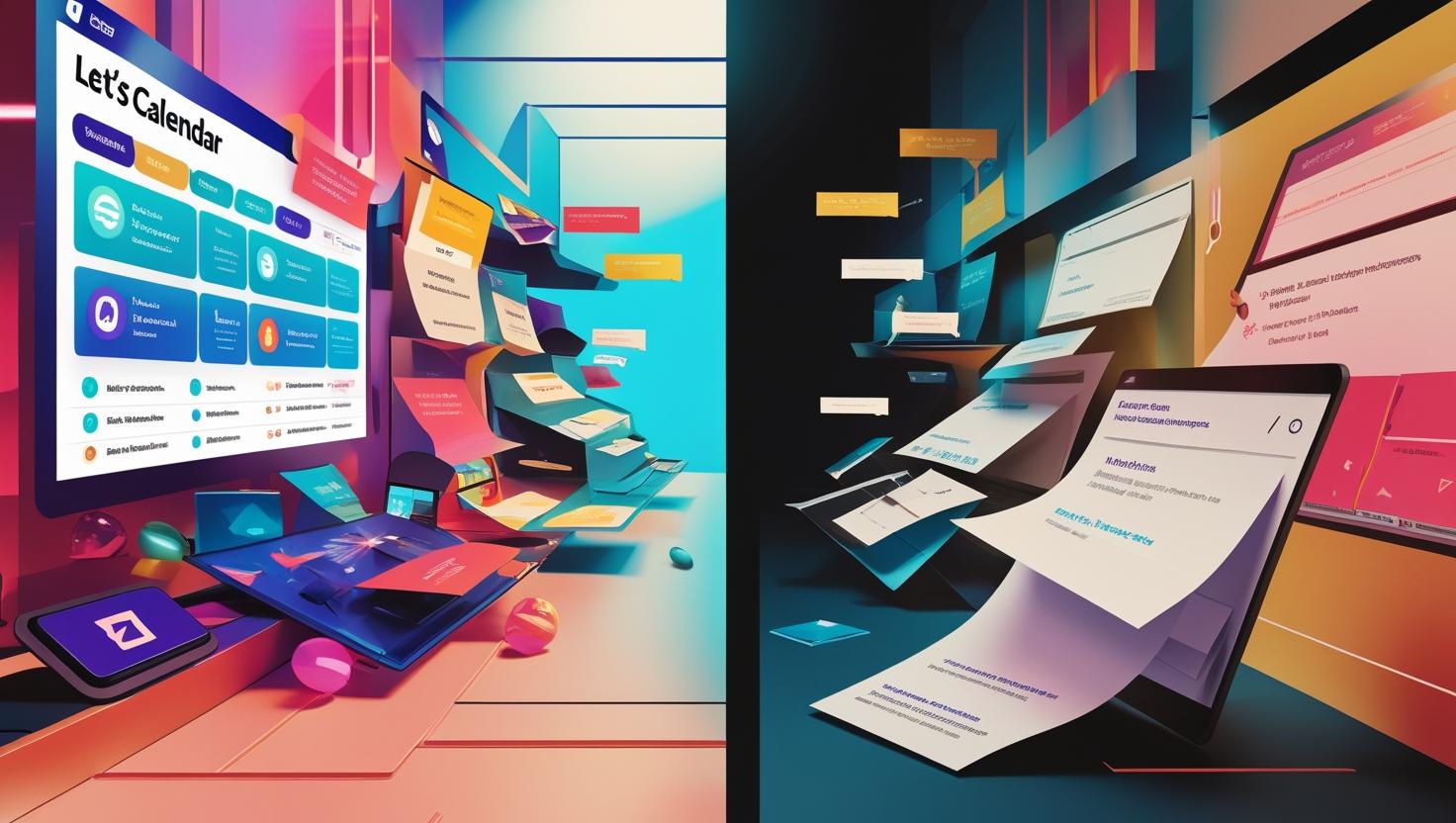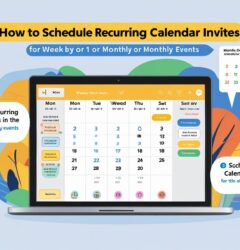- Email: [email protected]
- phone: +44 (0) 203 916 5117
25 Jun

Open rates and click-through percentages might warm a marketer’s heart, but they don’t pay for coffee breaks or impress sponsors. Every empty chair translates into lost revenue, last-minute logistics chaos, and a dent in brand credibility. As events grow more global—and attention spans shrink—organizers must shift from Traditional email to focus from sending invites to guaranteeing attendance.
That’s where Let’s Calendar the browser-based scheduling platform. challenges the decades-old dominance of traditional email blasts. Instead of hoping recipients read, click, and manually add your webinar to their timetable, Let’s Calendar drops a personalized, time-zone-accurate appointment straight onto each attendee’s calendar—then tracks RSVPs in real time.
Traditional Email Invites: Familiar, Yet Full of Friction
A classic campaign looks like this:
- Craft HTML with event details.
- Embed a static time (often in the organizer’s zone).
- Include a button or link to an external RSVP form.
- Blast the list and cross your fingers.
Where Email Falls Short
|
Pain Point |
Impact on Attendance |
|
Inbox Overload |
Emails vanish beneath newsletters and sales pitches. |
|
No Native Reminders |
Attendees forget, or can’t find the message at show-time. |
|
Manual Follow-Ups |
Ops teams spend hours chasing responses and updating spreadsheets. |
|
Time-Zone Errors |
A single “EST” label confuses global audiences, causing no-shows. |
|
Static Assets |
Changing a speaker bio means resending the entire invite and risking spam filters. |
Even when you attach a universal .ics file, recipients must still open, download, and import it—steps many simply skip.
Let’s Calendar: Purpose-Built for 2025’s Hybrid Events
Let’s Calendar flips the script by treating the calendar entry itself as the invitation. Instead of relying on email engagement, it leverages Google, Outlook, and Apple calendars—the very apps people already use to run their days.
Core Advantages
- Calendar-Native Delivery: Events appear in the attendee’s schedule with native reminders—no inbox hunting.
- 1:1 Personalization: Unique Zoom links, seat numbers, or VIP codes merge automatically without exposing private data.
- Real-Time RSVP Dashboard: Organizers know the exact accept, decline, or tentative count within seconds.
- One-Click Scaling: Need to send bulk meeting invites to 500 executives? Import a CSV, hit Send, and you’re done.
- Time-Zone Intelligence: A single master schedule converts perfectly for every locale, sparing guests the “What time is that for me?” math.
Feature Face-Off: Email vs Let’s Calendar
|
Feature |
Traditional Email |
Let’s Calendar |
|
Delivery Channel |
Email inbox |
Calendar event slot |
|
RSVP Tracking |
Manual or delayed |
Live dashboard |
|
Reminder System |
Optional, extra tools |
Automatic pop-ups |
|
Update Workflow |
“Send to all” again |
Silent calendar push |
|
Time-Zone Handling |
Manual text |
Auto-converted |
|
Add-to-Calendar UX |
External link or .ics |
Embedded with add calendar to event buttons |
|
Personal Data Security |
Bcc risks |
Discreet 1:1 merge fields |
Step-by-Step: How Let’s Calendar Works
Import or Sync Your List
- Drag-and-drop a CSV, or connect HubSpot, Salesforce via Zapier.
Create the Event
- Title, description, date/time, and default zone in a single form.
- Toggle RSVP and reminder settings.
Personalize at Scale
- Insert merge tags such as {{First Name}}, {{Company}}, or a confidential {{Join Link}}.
- Each invite becomes a unique asset—perfect for NDA-level boardrooms.
Choose Delivery Channels
- Gmail Add-On: With two clicks, you send bulk meeting invite in gmail straight from your corporate inbox, retaining branding and labels.
- Microsoft 365 Connector: Generate bulk meeting invites in o365 that flow through Exchange and appear instantly in Outlook calendars.
- API to Google: Trigger bulk calendar invites in google for registration pages or nurture workflows.
Send & Track
- Hit Send. Guests receive their personalized entry plus a native Yes/No/Maybe prompt.
- Watch live counters climb in your Let’s Calendar dashboard. If numbers dip, schedule automatic nudges instead of drafting a send mass meeting invites in outlook blast manually.
Cross-Platform Deep Dive
Google Workspace
Let’s Calendar uses Google’s event API to embed a unique UID in each entry. When attendees respond, their replies sync back instantly—no need to reconcile bulk calendar invites in google with separate spreadsheets.
Microsoft Outlook & Teams
Whether you target corporate tenants with bulk meeting invites in o365 or notch a send mass meeting invites in outlook triggers for external partners, Let’s Calendar’s .ics files include hidden metadata to track every click.
Gmail & Google Mail Servers
The Chrome extension surfaces an “Add to Calendar” pane inside Compose. With one action you send bulk meeting invite in gmail to thousands—each entry still personalized and tracked.
Apple Calendar & iCloud
Every invite ships with VTIMEZONE blocks, guaranteeing accuracy for iOS devices and Mac desktops—even across daylight-saving changes.
Landing-Page Widgets
Drop an addevent or add to event button on your registration page; one tap writes the session to any major calendar app, while Let’s Calendar still captures the RSVP. (First use for each term.)
Proof in Numbers: Real-World Case Studies
|
Organization |
Event Type |
Delivery Switch |
Attendance Lift |
|
SaaS Vendor |
Monthly Demos |
Email → Let’s Calendar |
31 % → 47 % (+16 pp) |
|
Global Bank |
Investor Roadshow |
Email → Calendar-Native |
42 % → 63 % (+21 pp) |
|
EdTech Firm |
Certification Webinars |
Mixed → Pure Calendar |
28 % → 45 % (+17 pp) |
Notably, the EdTech team used send multiple calendar invites for staggered cohorts, yet managed everything in one dashboard.
ROI Calculator: Time & Money Saved
Imagine your webinar targets 2 000 opt-ins:
- Email Only: 30 % show-up → 600 attendees
- Let’s Calendar: 50 % show-up → 1 000 attendees
At $25 revenue per attendee, that’s $10 000 extra on day one, not counting improved sponsor satisfaction or reduced manual labor.
Best Practices for Maximum Attendance
- Send first invite 14 days out and schedule Let’s Calendar’s auto-reminders at T-48 h and T-1 h.
- Use compelling “Location” text (e.g., “? LIVE | Growth Hacks 2025”)—it shows on phone lock screens.
- Test across Google, Outlook, and Apple; Let’s Calendar’s sandbox environment makes this a two-minute task.
- Embed an “add calendar” link in your thank-you page for late registrants (second use; compliant).
- Segment follow-ups: VIPs get white-glove reminders; general attendees receive a quick calendar “poke.”
Need to re-schedule a session? Push an update—no duplicates, no spam flags, and no need to send multiple calendar invites from scratch.
Security & Compliance Snapshot
- TLS Encryption on every message pathway.
- GDPR, CCPA, & ISO 27001 alignment with regional data centers.
- Role-Based Access Controls and full audit trails for every send mass meeting invites in outlook action or update.
Final Verdict: Calendar-Native Wins—Hands Down
In a showdown between bloated inboxes and streamlined schedules, Let’s Calendar converts interest into confirmed attendance, builds trust with 1:1 personalization, and frees operations teams from tedious follow-ups.
If boosting show-up rates, impressing sponsors, and simplifying workflows top your priority list, it’s time to migrate from static email blasts to calendar-native engagement.
Ready to see the difference for yourself?
Book a live demo of Let’s Calendar and empower your next event with invitation technology built for the modern, multi-time-zone world.









Recent Comments